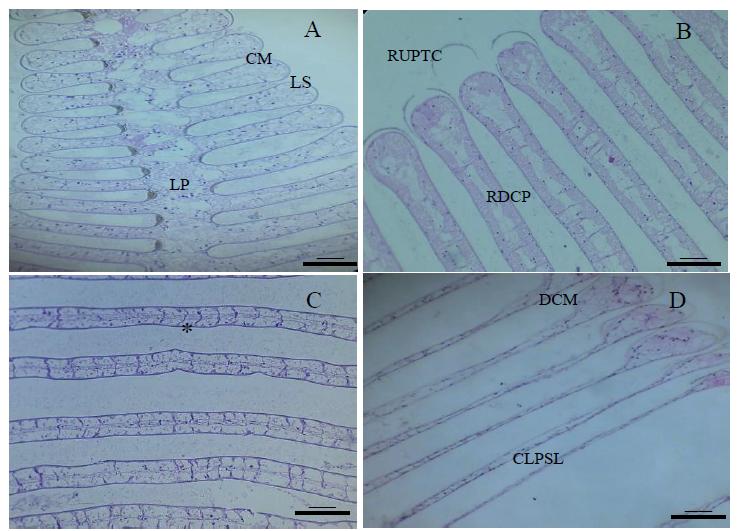| Elementos |
Localização |
Tipo de amostra |
Intervalos |
Referências |
| Cu, Pb, Zn, Ni e Co |
Baía de São Marcos/MA entre as coordenadas 26º02’ - 26º28’S e 48º28’ - 48º50’W, onde está localizado o Complexo Portuário de São Luís |
Água |
Cu, 0,016 a 0,054 mg. L-1;
Ni, 0,0480 a 0,0877 mg. L-1
Co, 0,0061 a 0,016 mg. L-1;
Pb, 0,0085 a 0,093 mg. L-1;
Zn, 0,0032 a 0,0088 mg. L-1. |
Furtado, 2007FURTADO, J.G.C. Estudo de impactos ambientais causados por metais pesados em água do mar na baía de São Marcos: correlações e níveis debackground. 2007. 74f. Dissertação (Mestrado em Química Analítica) - Faculdade de João Pessoa, Universidade Federal da Paraíba, João Pessoa, PB.
|
Nitrito/nitrato,
silicato e fosfato em mg. L-1
|
Baía de São Marcos/MA P1 (Ponta da Madeira), P2 (Itaqui e Ponta da Madeira) e P3 (a jusante do Porto do Itaqui. |
Água |
Nitrito/nitrato mg. L-1 (2,59; 5,07; 4,40; 3,98; 1,36; 4,62; 2,28, 0,80; 2,94; 2,27); silicato mg. L-1 (9,44; 9,91; 15,62; 7,32; 15,48; 8,98; 12,43; 13,85; 5,23; 15,48); e fosfato mg. L-1 (15,63; 31,16; 20,22; 12,52; 28,68; 18,82; 15,13; 20,22; 12,52; 17,63); |
Sousa, 2009SOUSA, J.K.C. Avaliação de impactos ambientais causados por metais traço em água sedimento e material biológicos na Baia de São Marcos, São Luís-Maranhão. 2009. 110f. Tese (Doutorado em Química) - Universidade Federal da Paraíba, João Pessoa, PB.
|
| Cu, Pb, Zn, Cd, Ni, Fe, Al e Mn |
Baía de São Marcos/MA P1 (Ponta da Madeira), P2 (Itaqui e Ponta da Madeira) e P3 (a jusante do Porto do Itaqui |
Água |
Ferro, 5,41 mg. L-1 e 7,82 mg. L-1 (chuvoso) e 1,13 mg. L-1 e 21,13 mg.
L-1 para ferro e alumínio (estiagem).
Manganês, as concentrações variaram entre 0,02 e 0,06 mg. L-1 em período chuvoso.
Alumínio foi o que apresentou os maiores teores (36,32 mg. L-1). |
| Ni, Cr, Pb, Cu, Fe, Cd, Al e Mn |
Baía de São Marcos/MA P1 (Ponta da Madeira), P2 (Itaqui e Ponta da Madeira) e P3 (a jusante do Porto do Itaqui |
Sedimento |
Fe (0,010) e Al (4. 10-3) com maiores concentrações. |
| Ni, Cr, Pb, Cu, Fe, Cd, Al e Mn |
Baía de São Marcos/MA P1 (Ponta da Madeira), P2 (Itaqui e Ponta da Madeira) e P3 (a jusante do Porto do Itaqui |
Peixe |
Os valores médios de metais-traço detectados nos tecidos dos peixes foram de: 1,2 mg kg -1 para Cu, 164,65 mg kg -1 para Zn, 25,38 para Fe, 7,32 mg kg -1 para Al e 2,2 mg kg -1 para Mn. Fe e Zn apresentaram as maiores concentrações nos tecidos analisados. |
| Al, Cd, Pb, Cr, Fe, Hg), benzeno, fenóis totais, tributilestanho (TBT) e bifenilos policlorados (PCB) |
Baía de São Marcos/MA - Região Portuária de São Luís (02º43’14”S,44º23’35”W) e Ilha dos Caranguejos - Cajapió(02°49’06”S, 44°29’05”W) |
Água e sedimento |
Concentrações maiores para a área portuária em relação à de referência. E estavam acima dos limites máximos prescritos pela legislação federal brasileira na Resolução 357 do Conselho Nacional do Meio Ambiente do Brasil. |
Carvalho-Neta et al, 2012 |
| Cd, Cr, Cu, Fe, Mn, Ni, Se, V e Zn, Al, |
Baía de São Marcos-São Luís-MA e Raposa -MA |
Sedimento e tecido de caranguejo |
Os metais que mais se acumularam nos hepatopâncreas dos caranguejos foram Fe>Zn>Cu>Mn>Ni>Al>Ba. Concentração total (somatório) de metais nos caranguejos da
AI (102,73±47,74 μg/g). |
Rocha, 2017ROCHA, C.H.S. Bioacumulação de metais e presença de metalotioneína no caranguejo-uçá, Ucides cordatus (LINNAEUS, 1763). 2017. Dissertação (Mestrado) - Universidade Federal do Maranhão, Programa de Pós-Graduação em Biodiversidade e Conservação, São Luis, MA.
|
| As, Cd, Pb, Cu, Cr, Hg, Ni, Zn |
Baía de São Marcos-São Luís - MA e Raposa - MA |
Sedimento |
Concentrações maiores para a área portuária em relação à de referência. E estavam acima dos limites máximos prescritos pela legislação federal brasileira na Resolução 357 do Conselho Nacional do Meio Ambiente do Brasil. |
Oliveira et al., 2019OLIVEIRA, S.R.S.; BATISTA, W.D.S.; SOUSA, J.B.M. et al. Enzymatic and Histological Biomarkers in Ucides cordatus (Crustacea, Decapoda) in an Industrial Port on the North Coast of Brazil. Bull. Environ. Contamination Toxicol., v.102, p.802-810, 2019.
|





